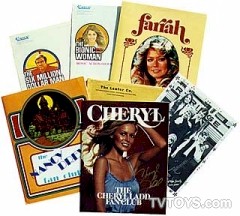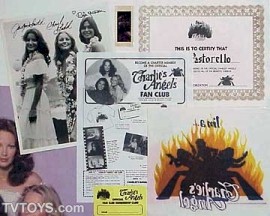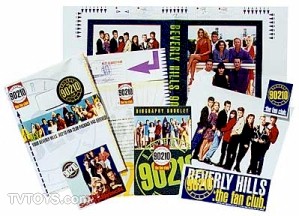 |
As seen in Pop Culture
Collecting Magazine
|
 |
| - Published September,
1999 -
|

by Bill D. Morgan and Greg Davis
Almost since the birth of television, fans of popular programs have
expressed adoration for their favorite stars or TV shows in a variety of ways. The most
prevalent method has been to join a fan club. To the benefit of TV memorabilia hobbyists,
the plethora of clubs spawned over the years has left a trail of exclusive merchandise and
invaluable club kits.
 |
A variety of kits were offered during the 1970s
for only a few dollars. Today, the average value
of a complete kit is about $75. |
|
During the early years of television, a modest number of fan clubs
were formed. For example, fans in the 1950s had a Dennis the Menace fan club, while
during the 1960s, “Sally’s Friends” was formed to satisfy audiences of both
Gidget and The Flying Nun.
However, the real explosion of fan clubs occurred during the 1970s.
During this era, clubs were backed by heavy promotional ads that appeared in everything
from teen magazines to the back of cereal boxes. Many of these clubs were initiated by
publicists, who used them to wage heavy ad campaigns to promote the shows and the
celebrities who starred in them. Fans and collectors only stood to benefit from those
marketing efforts.
Prior to that time, kits were constructed modestly and contained
plain paper items and black and white photos. Starting in the 1970s, however, kits were
professionally designed and more elaborately made than their predecessors. Many included
additional benefits like quarterly newsletters, stickers and records. Perhaps the biggest
change was in the use of full color photos.
Fan Club Corporation of America (FCCA) was the largest producer of
kits during the late ’70s and early ’80s. The average cost of their memberships
was $6. Two top sellers for FCCA were the 1977 and 1980 Farrah Fawcett kits. Fans joining
Farrah’s 1977 club received a 9 x 12-inch color folio packed with photos and
information.
 |
| The “Charlie’s Angels”
fan club was licensed by Spelling-Goldberg Productions and sold for $5 in 1977. Today it
is one of the most valuable TV fan club kits and is valued at $300. |
Included was an official plastic membership card (similar to a
credit card) with a color photo of Farrah, a membership scroll, an 8 x 10 black and white
photo, a 4 x 5 color photo, biography profile, a 16 x 20 color poster, color wallet
photos, a 5 x 7 color photo, and discounts for related posters and other memorabilia. A $6
investment in 1977, a complete Farrah kit is now worth well over $100. The 1980 kit
includes similar contents, but with a different folio and photographs.
Although the FCCA was one of the largest fan club management
organizations around, it wasn’t the only game in town. Laufer Publications’ Tiger
Beat and Fave magazines offered their own style of fan club kits, including
ones for The Partridge Family, David Cassidy, The Brady Bunch, Bobby Sherman
and Leif Garrett.
With a reader base of over one million, Laufer Publications was a
major contender in the fan club arena. Laufer’s offerings weren’t quite as
colorful and luxurious, but they cost only half as much. Most of their kits consisted of
black and white photos, simple cardboard membership cards, and black and white biography
booklets.
 |
| Originally offered for only $2 plus
50¢ for postage and handling, this “Brady Bunch” kit sold for more than 100
times that amount in a recent Internet auction. |
However, the company did include a desirable premium in some of its
packets – a recorded welcome message in the celebrity’s own voice. For example,
the David Cassidy kit came with a 7-inch blue cardboard record graced with a black
silhouette of his visage. The kit also included a 1972 poster calendar, biography booklet,
a 5 x 8 color photo, Luv Stickers and a membership card. Two similar kits for The
Partridge Family also boasted images of the teen idol. All three kits are valued at
$150 each.
After the avalanche of kits that hit during the 1970s, fan club
activity subsided. Only a handful of official kits have been issued in recent years, among
them a 1980s kit for The A Team, and another for Beverly Hills 90210
in the 1990s.
The 90210 kit was handsomely designed in traditional fan club
fashion, complete with book cover, embroidered logo patch, membership card, bumper
sticker, biography booklet and a mini-poster. Members also received a series of
newsletters titled The West Beverly Blaze. Considering the $20 cost to become a
member, it’s unfortunate that the club had an untimely demise after only three
newsletters were issued.
 |
In 1992 “Beverly
Hills 90210: The Fan Club” was offered for $19.95. In typical fan club tradition,
members were offered exclusive merchandise to purchase. |
Dramatic changes in the way fan clubs are formed have occurred in
recent years. Today, just one or more devoted fans create and run many of the existing
clubs. Without the financial backing of club management companies or show promoters, these
fans have been forced to think of creative ways to bring other fans together.
Many rely on word-of-mouth, distribute flyers, or print inexpensive
advertisements in local newspapers or collectibles publications. The fastest-growing
medium for these enterprises has been the Internet. The next time you’re browsing a
web-based search engine, try entering some of your favorite TV stars and show names as
keywords. You may be surprised at what you’ll find.
Those who are looking for a particular fan club, or want to start
one of their own, also should check with The National Association of Fan Clubs. The NAFC
was founded over 20 years ago and maintains a huge database of fan clubs. By sending a
written request for information, you can find out how to start a club, or how to get in
touch with an existing one.
The NAFC also publishes an annual directory of fan clubs. Letters
can be addressed to N.A.F.C., P.O. Box 7487, Burbank, CA 91510. You can also reach them by
phone at (818) 763-3280, or online at http://www.fanclubs.com.
|
From the publication Collecting Magazine
|
Greg Davis and Bill D. Morgan are the authors of
Collector’s Guide to TV Toys and Memorabilia — 2nd Edition
Website: TVTOYS.com
Copyright (c) TVTOYS.com, Odyssey
Publications. All Rights Reserved. |
|